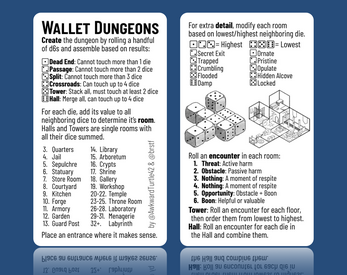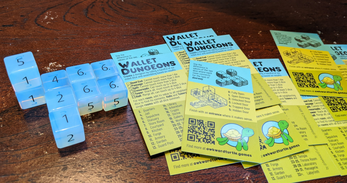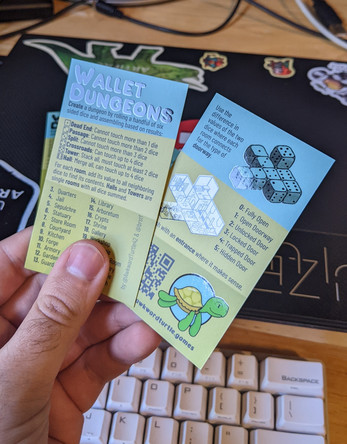Wallet Dungeons
A downloadable game
Roll a handful of dice, assemble following simple rules, and create a dungeon to explore in minutes!
A collaboration with Brian Stauffer, @brstf, who is also responsible for the excellent artwork.
See the Sci Fi sequel here: Wallet Stations
While supplies last the new colorful version is being included with purchases at: https://store.cairnrpg.com/
Video walkthrough by Ithaquas Bane:
Originally written for the Pleasure Not Business Card Jam.
French translation generously provided by go11um.
Spanish translation generously provided by David Hernandez, @deivijouns.
Portuguese (Brazil) translation generously provided by FriggingFrogs, @wilkawill.
Italian translation generously provided by Danilo Moretti, JustPlayWith.it, @JustPlayWith.
German translation generously provided by Dirk Remmecke.
Can I make my own Wallet Dungeons?
The text of Wallet Dungeons is licensed under the Creative Commons Attribution 4.0 International License. You can use any and all of it as long as you credit me!
The mechanics of Wallet Dungeons are uncopyrightable, so feel free to steal and adapt them as much as you like. I'd still appreciate a shout out, but it's not necessary!
| Status | Released |
| Category | Physical game |
| Rating | Rated 4.9 out of 5 stars (120 total ratings) |
| Author | AwkwardTurtle |
| Tags | Dungeon Crawler, Generator, One-page, system-agnostic, system-neutral, Tabletop role-playing game |
Download
Click download now to get access to the following files:
Development log
- Solo Session w/ Tunnel Goons!Sep 25, 2024
- Plain Text VersionJul 20, 2024
- Wallet Stations!Mar 11, 2023
- Color Version Fixed + License UpdateJan 20, 2023
- Video Walkthrough!Jan 19, 2023
- Typo Fix in Brazillian TranslationDec 07, 2022
- Available in print! Again!Nov 17, 2022
- New colorful and shiny version!Nov 11, 2022



Comments
Log in with itch.io to leave a comment.
This is such a cool system! I liked it so much that I included a version of it in this little location that I've been working on (with credits of course), feel free to grab one of the community copies!
https://wren-the-forrester.itch.io/elysian-apartments
Hey, super cool! The additional detail/graffiti/etc. tables I think will do a ton to differentiate and add character to the results. I love seeing different people’s takes on the core idea, so thanks for pinging me about this.
Hello there! I have Wallet Dungeons in my DriveThruRPG library. Are there any plans to update that download source with the new Plain Text Version file(s) you uploaded here?
Also, are there any plans to upload Wallet Monsters and Wallet Stations to DriveThruRPG?
Asking these questions solely for the sake of convenience and accessibility across multiple platforms. I could totally download them here, but I like using my DriveThruRPG library app to keep stuff organized.
Thanks in advance! Really love your products! Used Wallet Dungeons for my Black Hack campaign a few months ago and made a sick crawl that my players loved!
- P.S. I noticed that Wallet Monsters doesn't have a plain text version yet. Are there any plans for that too?
To be honest I sort of forgot I had started uploading things to DTRPG. I’ll update the Wallet Dungeons listing to include the plain text version, and continue my (slow) process of getting the rest of my stuff up there (including Wallet Stations).
Wallet Monsters is slated for a reformatting to bring it more in line with the other two, and when I do that I’ll include a plain text copy as well.
Super cool to hear you’ve used Wallet Dungeons at the table! I love hearing about it actually intersecting with people’s games!
Hey, just wanted to say thank you - your Wallet Dungeons pushed me to try game design on my own.
That’s awesome! Glad I could provide even a little bit of a push!
Hey! I recently got into solo RPG and I eventually came across Wallet Dungeon and your other stuff. It's great! I'd love to help you to translate it to Brazilian Portuguese. I'm a freelancer translator looking for building a portfolio.
That’d be rad! Please shoot me an email (found at https://awkwardturtle.games to avoid posting it here to be scraped by bots).
legal
I love this little card so much (via Tiny Library!), and it's one of the first things I show folks from my shelf'o'stuff when trying to explain what all these zines and print-outs I collect are about... :D:D:D
Question about "Encounter" rolls:
For "Hall", what do you mean by "combine them"?
Thanks for the kinds words!
My intent for “combine them” is your second example, to add them up. What this looks like is very much up to the reader though. Could be different encounters scattered throughout the large space, or a single encounter that has the characteristics of each rolled entry.
Another question. When you’re looking at what is adjacent, do you count the dice on the diagonal as well? I’ve been doing both (i.e. counting and not counting) and seeing which result feels better. Just curious as to your original intent.
Also, are you on reddit? If I post something there I’d like to be able to tag you.
My intent was just the cardinal directions, no diagonals, but as you say it works both ways.
I’m /u/AwkwardTurtle on reddit (not to be confused with the similarly named power mod whose hate mail I receive regularly) although I’m no longer hugely active there.
Good to know. Tks.
Hi. I’ve been finding this useful for inspiration, so I bought a copy. I don’t however quite understand the optional bit about room extra detail. Can you provide an example? E.g. the example in the pamphlet, or if you rolled [6][6][3][4][2] for example. The [6][6] is a hall, so you go for the lowest neigbouring die, which is [3]. Does this mean the hall is ‘OPULENT’? Thus, would room [4] (also lowest neighbour), be based off the [2] result to the right, and thus be “PRISTINE”? Whereas room [3] should be DAMP?
Thank you for the kind words!
And yes, you’re completely correct on how the details work! That’s the most confusing part of the card, and the bit I’m the least happy with.
Thanks for confirming that. I was thinking of using this to get into a #Dungeon24 type mode for this year. Just creating and drawing at least a couple of places using Wallet dungeons each week.
Any particular thoughts on the numbers of dice to roll? I’ve been using 9 or 10, but I could see using more might work. Then again, I can see just rolling 9 or 10, working out what that looks like, then combining with a building done previously.
…and thanks for such an interestingly simple game.
In my experience 9 or 10 dice is a good number. I don’t know that there are really hard limits, as it mostly just shifts the results of the larger rooms with larger numbers. I wouldn’t go significantly higher though, at least not without modifying it to split up Halls and Towers. Alternatively just roll handfuls separately, assemble, then connect the results.
That matches my intuition. Smalller numbers are good to start with. I think I tried 4,5 then 6 dice just to feel my way into the system. It started to feel good when I got to 8, 9, 10. Thank you for such an entertaining little game. I now need to make a bit more time to start drawing what the dice reveal.
I’d love to see what you end up with!
Great job! I like it!
I could see the colored version is different from the others.
Thanks!
And yes, each of the versions I’ve released (aside from the translations) have alternate back sides. So the normal one, colored version, and the one that’s in the back of Echelon Forest.
I was never entirely happy with how the detail generator worked so I make a new attempt at it each time I make a new version.
Great! Thanks for the explanation.
how do you print this?
The nice glossy copies are printed with a local printer as actual business cards, but it wouldn’t be hard to find a place that can do color + UV gloss. Even staples or fedex would do a decent job for pretty cheap (assuming you wanted a bunch of copies for some reason).
Otherwise I’ve seen people just home print either double sided, or single sided and fold, then trim and laminate.
I have used this every day for the last four months, but to help me build up and draw small blocks of a city I am working on (converting results to building types).
Have you ever thought of doing this for village or city building? Would be a hoot!
Awesome to hear it’s been so useful.
And I have actually gotten other requests for a city version, but I haven’t progressed it past some notes so far. I’ll move it up the priority list!
Hey, it's a brief mention, but we talked a little bit about Wallet Dungeons on our podcast:
https://goblinsandgrowlers.podbean.com/e/scratching-our-indie-game-itchio-the-go...
Awesome, thanks for the mention! Great recommendations otherwise as well, I’m familiar with Yokai Hunters Society but the others were new to me.
Also to answer you question, “AwkwardTurtle Games” is just me (David Lombardo) and Brian (of brstf.games) is a buddy of mine that I collaborate with a lot.
Hi, great genarator. I'll use soon. But I found a typo in Brazillian version: first page. The passage dice should be 2 dice instead of 1 dice. Cheers.
Whoops, thanks for the heads up. I’ll get that fixed.
fun!
This is a gem!
I'm having trouble understanding how to use labyrinths. I've build a dungeon, made sure I place everything according to the rules - and I ended up with multiple single-room labyrinths. How does one use such rooms?
Thanks!
Two answers to the labyrinth question:
First, you shouldn't be able to get the labyrinth result except on multi dice rooms (Towers and Halls). It is intended that if you have a room that's next to a Hall or Tower, you don't include the entire room in the sum, just the physical die that the room is touching. Small example but if you have [6][6][3] you'd have a Hall with a total of 15 (Arboretum) and a Split with a total of 9 (Kitchen). I wanted Labyrinth to only be likely to show up if you had a particularly large Hall or Tower, where it would makes sense that the interior could be broken up into a complicated maze. I just didn't have enough space to explain things fully enough to avoid confusion.
Second, the nice part of this system is that even if you don't resolve things the way I intended, you still end up with something you can use. In your case, if I ended up with several single room labyrinths, I'd be tempted to say that they're all connected with portals or some weird non-euclidean geometry. Or a less esoteric answer could be that those are all entrances to a labyrinth that stretches across the floor below the rest of the dungeon.
The third bonus answer is that the exact results the dice spit out is often not super coherent or useful as is, and requires a bit of finessing on the part of the user to make it work at the table.
Anyway, hope that's helpful!
A fun ttRPG setting & scenario generator. Clearly presented.
Really simple procedural maker, doesn't always come up with most logical arrays of rooms and story prompts but great as a springboard for imagination.
So, if I get 5's they are supposed to be stacked on top of each other. But what if I rolled only one 5?
Only one 5 means it's a very short tower!
The non-glib answer is that the generator fails a bit for some combinations of numbers. Rolling multiple fives means you have a tower, rolling just one makes it just another room and some of the specific rules don't make a ton of sense anymore.
I'm inspired to work on something similar - Wallet Wilderness or Wallet Social. I use this tool a lot for solo play, and I think both of these could be good expansions of your original incredible idea!
If you make either of those please let me know! I'd love to see what other people can do with this idea!
Really inventive use of dice. I'm printing and laminating a copy for my GM toolbox.
This is really nice. Appreciate both the layout and the concept. Gonna recommend it to all my friends or anyone who will listen. Will be very helpful in solo rpgs.
Hey! great generator.
I had a question about Towers. If I roll say three 5s, do i stack all of these into a single tower?
If so, my assumption is that I use the neighbours in a top-down view to determine Room and Detail for the entire tower? Is this right?
Yeah, you'd stack all the 5's into a single tower three dice high.
The way I determine the room is to add up the entire tower (in the example on the card it's 10+neighbors = 19). Then for things that neighbor the tower, I only count the specific dice that are physically in contact (so for the 3 die it only gets +5 from the tower).
However! It totally works either way you do it, it just shifts the results on the Room table up or down. So if you want more low results only count the top down view, if you want more high results count the entire merged rooms.
Nice and clean!
Very nice, I'll give it a go.
Hi ! Thanks for your generator it's really nice. I have a question for the "extra detail" of each room. Could you explain how to determine which value to take (highest/lowest) is it me that choose if for example i have 2 die 3 and 2 die 5 ?
Thank you :)
I agree it's unclear, unfortunately space constraints meant I couldn't figure out a good way to explain it better. Here's how it's supposed to work:
Pick the room you want to add details to.
If it's a 1, 2, or 3 look at it's highest neighbor. Check the table under [1][2][3] and use the detail that matches the highest neighboring die.
If it's a 4, 5, or 6 look at it's lowest neighbor. Check the table under [4][5][6] and use the detail that matches the lowest neighboring die.
So as an example, if you use the die layout that's on the card, the Throne Room (two 6s) has a 3 as it's lowest neighbor, so it's "Pristine".
Or the Jail die (the 1 near the rear) as a highest neighbor of 3, so it's "Trapped".
Alright thank you for your answer i get it now. I also thought that it was a space constraint that forced you to not explain more.
I like your project, if you want a French translation don't hesitate to ask and give me an email address to send you the translation.
Thank you :)
That would be really cool! If you want to email me at DavidJLombardo@gmail.com we can talk more about it.
Would you also be interested in a Spanish translation? I'm up for it!
Absolutely, please feel free email me about it.
Aso if you like an Italian version just ask
Absolutely! Please shoot me an email so we can talk about it.